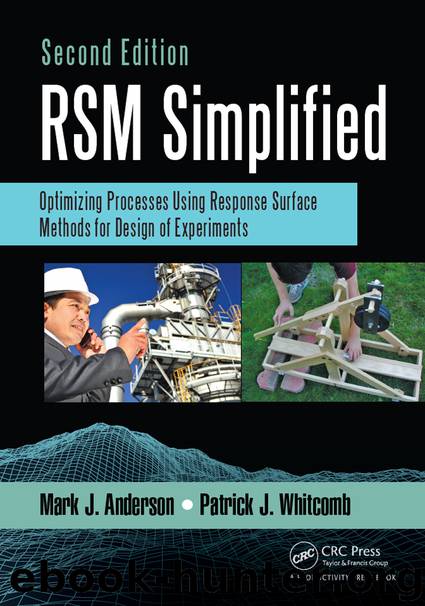RSM Simplified by Mark J. Anderson & Patrick J. Whitcomb

Author:Mark J. Anderson & Patrick J. Whitcomb
Language: eng
Format: epub
Publisher: CRC Press
Figure 6A.1 Simplex with the evaluation of response.
The labels describe hypothetical rankings of overall desirability in the 2D factor space. Here are the rules according to the originators of simplex optimization (Spendley et al., 1962):
1. Construct the first simplex about a random starting point. The size can vary, but a reasonable side length is 10% of the coded factor range.
2. Compute the desirability at each vertex.
3. Initially, reflect away from the worst vertex (W). Then, on all subsequent steps, move away from the next-to-worst vertex (N), from the previous simplex.
4. Continue until the change in desirability becomes very small. It requires only function evaluations, not derivatives.
Figure 6A.2 may help a bit by picturing a move made from an initial simplex for three factors—called a “tetrahedron” in geometric parlance.
The use of next to worst (N) from the previous simplex ensures that you won’t get stuck in a flip-flop (i.e., imagine going down rapidly in a rubber raft and getting stuck in a trough). The last N becomes the new W, which might better be termed as a “wastebasket” because it may not be worst. If you’re a bit lost by all this, don’t worry—as you can see in Figure 6A.3, it works!
This hypothetical example with two factors, temperature and catalyst, shows how in a fairly small number of moves, the simplex optimization converges on the optimum point. It will continue going around and around the peak if you don’t stop it (never fear, the programmers won’t allow an infinite loop like this to happen!).
So far, we’ve shown simplexes of a fixed size, but it’s better to allow them to expand in favorable directions and, conversely, contract when things get worse instead of better. Another few lines of logic, which we won’t get into, accomplish this mission of making variable-sized simplexes (Nelder and Mead, 1965). Figure 6A.4 gives you a view of how this works for optimizing a response.
Download
This site does not store any files on its server. We only index and link to content provided by other sites. Please contact the content providers to delete copyright contents if any and email us, we'll remove relevant links or contents immediately.
| Automotive | Engineering |
| Transportation |
Whiskies Galore by Ian Buxton(41525)
Introduction to Aircraft Design (Cambridge Aerospace Series) by John P. Fielding(32885)
Small Unmanned Fixed-wing Aircraft Design by Andrew J. Keane Andras Sobester James P. Scanlan & András Sóbester & James P. Scanlan(32570)
Craft Beer for the Homebrewer by Michael Agnew(17930)
Turbulence by E. J. Noyes(7697)
The Complete Stick Figure Physics Tutorials by Allen Sarah(7135)
Kaplan MCAT General Chemistry Review by Kaplan(6594)
The Thirst by Nesbo Jo(6432)
Bad Blood by John Carreyrou(6271)
Modelling of Convective Heat and Mass Transfer in Rotating Flows by Igor V. Shevchuk(6219)
Learning SQL by Alan Beaulieu(6032)
Weapons of Math Destruction by Cathy O'Neil(5825)
Man-made Catastrophes and Risk Information Concealment by Dmitry Chernov & Didier Sornette(5644)
Digital Minimalism by Cal Newport;(5388)
Life 3.0: Being Human in the Age of Artificial Intelligence by Tegmark Max(5182)
iGen by Jean M. Twenge(5158)
Secrets of Antigravity Propulsion: Tesla, UFOs, and Classified Aerospace Technology by Ph.D. Paul A. Laviolette(4984)
Design of Trajectory Optimization Approach for Space Maneuver Vehicle Skip Entry Problems by Runqi Chai & Al Savvaris & Antonios Tsourdos & Senchun Chai(4837)
Electronic Devices & Circuits by Jacob Millman & Christos C. Halkias(4744)
